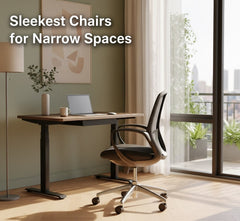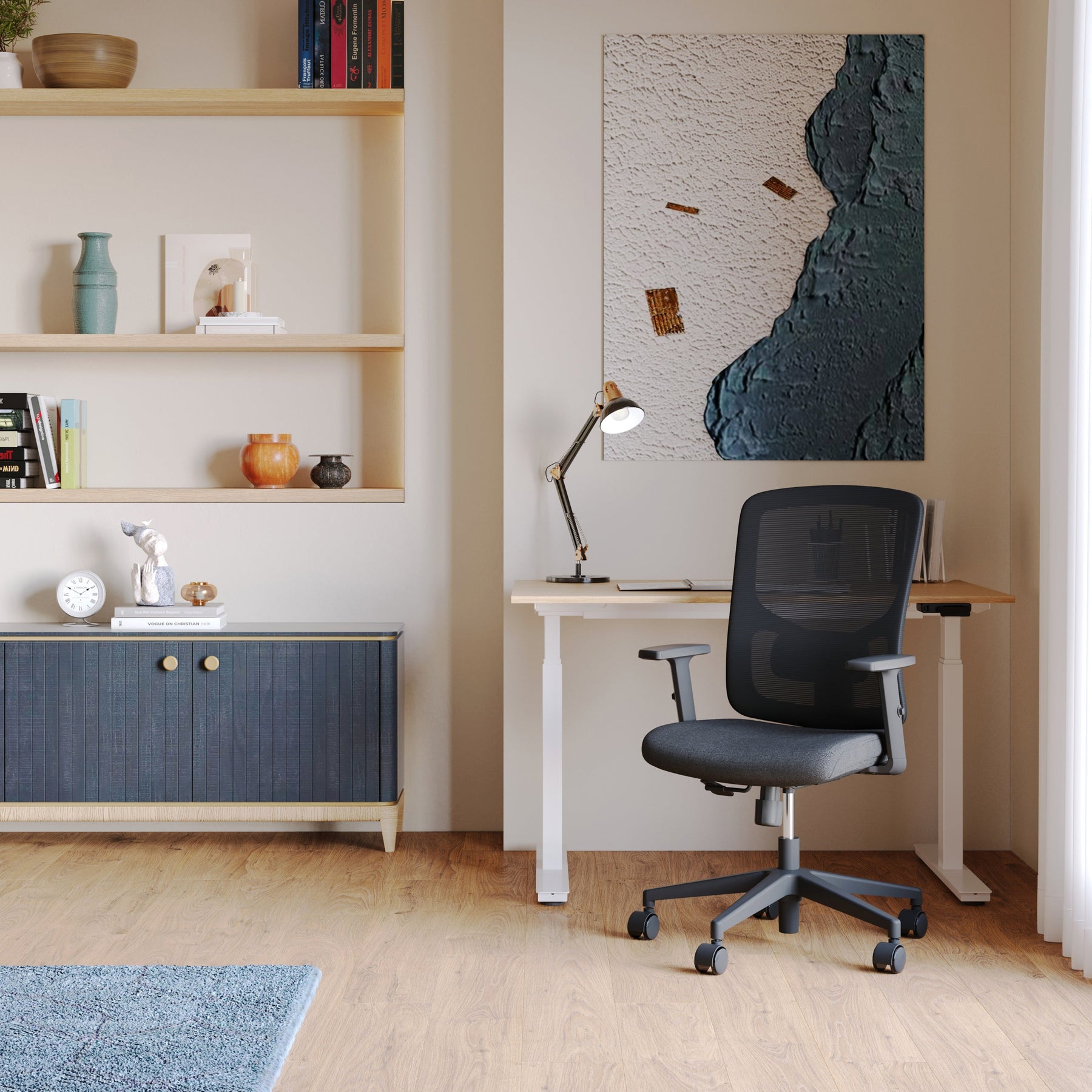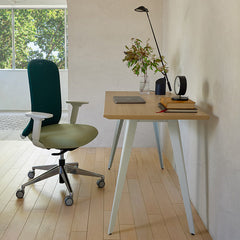Get 10% off your first order
Find the office furniture that’s designed to match your style, comfort, and needs perfectly. Subscribe
Sleekest Chairs for Narrow Spaces

Visit quiz page to see how we makes it easy to create an inspiring workplace


For too long, office workers treated their chair and their desk as separate entities. However, achieving true, sustained productivity requires recognizing them as an integrated system—a power duo. An ergonomic chair can be useless with a fixed, mismatched desk, and the benefits of a standing desk are wasted with a static, unsupportive chair. Your goal is not to buy furniture, but to build a command center that actively supports your body's need for dynamic movement and alignment.
The true cost of poor posture goes beyond simple back pain; it includes reduced energy, fragmented focus, and long-term musculoskeletal issues. By investing in tools designed for flexibility and support, you are investing directly in your cognitive performance. This integrated approach ensures that whether you are sitting or standing, your body remains in its optimal, neutral position.
The modern workstation philosophy rejects the static approach. It recognizes that the human body is designed to move, and the best furniture facilitates this movement. This means prioritizing adjustability and adaptability. When your desk and chair work seamlessly together, the energy your body usually spends fighting discomfort is freed up, making deep work effortless.
The foundation of a dynamic setup is a high-quality, fully adjustable height-adjustable standing desk. This tool ensures you can quickly transition between sitting and standing, a core practice for maintaining circulation and energy throughout the workday.
The chair is the primary anchor for your body during periods of focused sitting. It must be more than a cushion; it must be a precise instrument of support, maintaining the spine's natural curvature and ensuring that pressure is distributed evenly.
A truly ergonomic chair, such as a high-performance ergonomic office chair, must offer comprehensive adjustability to fit your unique body. These five adjustments are non-negotiable for sustained comfort and health:
Chair Adjustment Checklist:
☐ Seat Height: Ensures feet are flat on the floor and elbows are level with the desk.
☐ Seat Depth: Prevents the back of the knees from hitting the seat edge, protecting circulation.
☐ Lumbar Support: Adjustable height and tension to fit the natural curve of the lower back.
☐ Armrest Adjustment (Height and Width): Allows shoulders to relax fully by supporting the elbows.
☐ Tilt Function: Permits reclining and rocking, enabling essential shifts in posture.
While the chair supports sitting, the standing desk facilitates the crucial transition to movement. Prolonged sitting, even in the best chair, restricts circulation and slows metabolism. The desk's role is to make the shift to standing effortless and frequent.
Alternating between sitting and standing throughout the day is scientifically proven to reduce fatigue, increase energy expenditure, and improve overall mood. The key is to make this transition simple enough that you do not resist it.
The ideal sit-stand ratio varies, but the most effective approach is frequent transitions.
|
Activity |
Recommended Posture |
Duration Guideline |
Physiological Benefit |
|
Focused Typing |
Sitting (Fully Supported) |
45-60 minutes |
Maximized stability for precision. |
|
Phone Calls/Meetings |
Standing or Pacing |
15-30 minutes |
Boosts energy; prevents circulatory stagnation. |
|
Detailed Work |
Sitting (with micro-breaks) |
60 minutes |
Reduces strain from sustained visual effort. |
The most common failure point in ergonomic design is the height mismatch between a fixed desk and an adjustable chair. If your desk is too high, even a perfect chair cannot prevent shoulder shrugging and wrist strain. If the desk is too low, you are forced to slouch.
The ideal workstation exists in the "Goldilocks" zone where the desk surface and the chair's armrests allow your elbows to rest comfortably at a 90 to 100-degree angle, with your shoulders completely relaxed, regardless of your posture.
If you are using a non-adjustable fixed-height modern office desk, the chair is the only variable you can truly control. You must adjust the chair height until the 90-degree elbow rule is met, and then use a footrest (like a stack of books) if your feet no longer touch the floor. This compromise is necessary to prioritize upper body alignment.
Whether sitting or standing, your monitor height must be perfectly aligned with your eye level. A dynamic desk and a supportive chair are useless if the screen placement forces your neck to bend forward or tilt up.
The goal is a neutral neck position, meaning your head is balanced directly over your spine. The top edge of your monitor screen should be at or slightly below your horizontal eye line. This slight downward gaze is the most restful position for the eyes and neck.
Screen Setup Strategies (Enumeration):
Use External Monitors: Separate the screen from the keyboard (especially with laptops) to allow independent height adjustment.
Adjustable Arm Support: Use a fully adjustable mount or arm to ensure the monitor can move seamlessly with your sit-stand transitions.
Distance Check: Ensure the monitor is approximately an arm's length away to prevent eye strain.

Ergonomic furniture is often perceived as bulky, but modern design addresses the need for compact solutions. In small home offices, a dedicated ergonomic setup is even more critical for defining space and reducing clutter, which is a key psychological disruptor.
Small spaces require furniture that works hard without taking up unnecessary visual or physical space. For those with limited area, a sleek, narrow desk solution is essential. A specialized Small Standing Desk Hawaii provides the crucial sit-stand function without dominating a smaller room or apartment footprint, proving that health and space-saving design can be seamlessly combined.
Beyond the physical benefits, a well-integrated desk and chair system offers profound psychological advantages. The sense of control and comfort directly impacts your cognitive function and ability to resist burnout.
When your physical environment supports you, you expend less mental energy fighting discomfort or distraction. This conservation of resources directly feeds into your psychological resilience. Research confirms that environmental factors significantly influence job engagement and well-being.
The study on work engagement and well-being emphasizes that perceived control over one's work environment is a key job resource. A setup that is fully adjustable and comfortable reinforces this sense of control, which is essential for minimizing stress and boosting mood.
While the standing desk allows you to stand, the ergonomic chair's design influences the quality of your standing breaks. The chair should be easily movable and not an obstacle.
When transitioning from sitting to standing, you should be able to smoothly push the chair away without difficulty. This may sound minor, but friction in the transition process makes you less likely to move, defeating the purpose of the dynamic desk.
Chair Mobility Checklist:
☐ Caster Quality: Ensure the chair's wheels roll smoothly on your floor surface (consider a floor mat if necessary).
☐ Armrest Clearance: Confirm the armrests can be lowered enough to roll cleanly under the desk when standing (if you prefer to keep the chair tucked close).
☐ Return Position: Note the ergonomic settings so you can easily reset the chair's height and tilt upon sitting again.
The integrated system must ensure that your wrists and forearms remain neutral while typing and mousing, both sitting and standing. This is where the coordinated height of the desk surface and the chair's armrests become crucial.
Your wrists should not be bent up or down; they should remain flat, in line with your forearms. Bending the wrists for hours compresses the carpal tunnel, leading to discomfort and potential injury.
Keyboard Tray: If your desk is too high when sitting, a sliding keyboard tray can lower the typing surface to the correct level.
Ergonomic Accessories: Use a high-quality mouse and keyboard designed to support the natural curve of the hand and wrist.
Avoid Hard Edges: Do not rest your wrists on the hard edge of the desk; allow your forearms to rest gently on the desk surface or a properly adjusted armrest.
A comprehensive ergonomic system considers not only structure but also comfort factors like temperature and breathability. These elements, primarily governed by chair and desk material, contribute to long-term endurance.
Sitting for long periods in a chair with poor airflow can lead to heat buildup and discomfort, which is a distraction that breaks focus.
Comfort Factors (Table):
|
Component |
Feature |
Ergonomic Benefit |
|
Chair Seat/Back |
Mesh or breathable fabric. |
Promotes airflow; prevents heat and moisture buildup. |
|
Desk Surface |
Matte finish (non-reflective). |
Reduces glare and visual fatigue. |
|
Material Quality |
Sturdy, durable materials. |
Ensures stability, eliminating wobble that causes mental distraction. |
The greatest ergonomic benefit comes not from the purchase, but from the habit of constantly adjusting and checking your alignment. The dynamic system of chair and desk must be used actively, not just set once and forgotten.
Every time you transition between sitting and standing, or even after a lunch break, perform a quick check of your posture. Are your shoulders relaxed? Are your elbows at 90 degrees? Is the screen at eye level? This simple habit ensures you maximize the value of your integrated system.
A dynamic chair and height-adjustable standing desk are not just office furniture; they are powerful preventive healthcare tools. By proactively supporting your musculoskeletal health, you are minimizing future pain, maximizing daily energy, and ensuring your body can keep up with your cognitive demands for years to come.

Your chair and your standing desk are two halves of one essential solution. When aligned and used dynamically, they create a symbiotic workspace that eliminates physical friction and frees up your mental energy for the tasks that truly matter. Stop thinking of them as individual pieces of furniture. Start treating them as an integrated system—your co-pilots in focus and health. Investing in this powerful duo is the final step toward building a truly pain-free, productivity-optimized work life.

Sleekest Chairs for Narrow Spaces

Mastering the Wood and Metal Fusion in Furniture

Ergonomics on a Budget: Hacks for a Healthy Work Setup
Get 10% off your first order
Find the office furniture that’s designed to match your style, comfort, and needs perfectly. Subscribe
Leave a comment